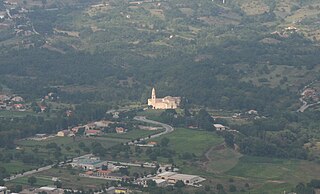
Giovanni di Pietro di Bernardone, known as Francis of Assisi, was an Italian mystic, poet, and Catholic friar who founded the religious order of the Franciscans. Inspired to lead a Christian life of poverty, he became a beggar and itinerant preacher.

The Franciscans are a group of related mendicant religious orders of the Catholic Church. Founded in 1209 by the Italian saint Francis of Assisi, these orders include three independent orders for men, an order for nuns known as the Order of Saint Clare, and the Third Order of Saint Francis open to male and female members. They adhere to the teachings and spiritual disciplines of the founder and of his main associates and followers, such as Clare of Assisi, Anthony of Padua, and Elizabeth of Hungary. Several smaller Protestant Franciscan orders or other groups have been established since the late 19th century as well, particularly in the Anglican and Lutheran traditions.

Assisi is a town and commune of Italy in the Province of Perugia in the Umbria region, on the western flank of Monte Subasio.

Montefalco is a historic small hill town in Umbria, Italy, with a population of 5,581 in August 2017. It has been settled since pre-Roman times, and retains many of its historic buildings. From 1446 to 1861 it was part of the Papal States. It is one of I Borghi più belli d'Italia.

The Basilica of Saint Francis of Assisi is the mother church of the Roman Catholic Order of Friars Minor Conventual in Assisi, a town in the Umbria region in central Italy, where Saint Francis was born and died. It is a papal minor basilica and one of the most important places of Christian pilgrimage in Italy. With its accompanying friary, Sacro Convento, the basilica is a distinctive landmark to those approaching Assisi. It has been a UNESCO World Heritage Site since 2000.

Blessed Jacoba of Settesoli (Italian: Giacoma de Settesoli; 1190–1273? was a follower of the Italian saint Francis of Assisi. She is also called Jacqueline Marie de Settesoli, or Brother Jacoba, as Francis had named her.

The Basilica of Saint Mary of the Angels is a papal minor basilica situated in the plain at the foot of the hill of Assisi, Italy, in the frazione of Santa Maria degli Angeli.

Puccio Capanna was an Italian painter of the first half of the 14th century, who lived and worked in Assisi, Umbria, Italy between 1341 and 1347. He is also called Puccio Campana.

Elias of Cortona was a close associate of Saint Francis of Assisi and one of the earliest followers to join the newly founded Order of Friars Minor. A lay brother, he rose to positions of significant leadership within the order, serving as both vicar general and minister general. Saint Francis himself appointed Elias vicar general in 1221.

The Basilica of Saint Francis is a historic church in the city of Bologna in northern Italy. Founded in the 13th century, it has been the property of the Conventual Franciscan friars since then. The church has been raised to the rank of a minor basilica by the Holy See.

Chiara Offreduccio, known as Clare of Assisi, is an Italian saint who was one of the first followers of Francis of Assisi.

San Martino Chapel is a chapel in the Lower Basilica of San Francesco in Assisi, Umbria, central Italy. Commissioned and funded by Cardinal Gentile Portino da Montefiore, it features a cycle of frescoes by Simone Martini (1313–1318), portraying the life of Saint Martin of Tours in 4th-century France.

San Francesco d'Assisi is a 16th-century-style church dedicated to Saint Francis of Assisi, located in Alcamo, province of Trapani, Sicily, southern Italy.

The Church of Saint Francis of Assisi is a Gothic-style, Roman Catholic church of Palermo. It is located near a major and ancient street of the city, via Cassaro, in the quarter of the Kalsa, within the historic centre of Palermo. The building represents the main Conventual Franciscan church of Sicily, and has the title of minor basilica.

The Treasure Museum of the Basilica of Saint Francis contains a collection of sacred art that is on display in two halls found on the northern side of the Cloister of Pope Sixtus IV which is part of the Sacro Convento in Assisi, Italy. The entrance is found on the second level of the Renaissance cloister behind the apse of the Basilica of Saint Francis, which houses the remains of St. Francis of Assisi. Since 1986 the museum has also displayed a collection of works donated to the Conventual Franciscan Friars by the Secular Franciscan and American art critic, Frederick Mason Perkins, who died in Assisi in October 1955.

The Convent of Saint Francis at Folloni is a Franciscan friary located near Montella in the province of Avellino in southern Italy. The monastery was founded by Saint Francis of Assisi in AD 1221–1222.

Mauro Gambetti, OFM Conv. is an Italian Catholic prelate who has served as archpriest of Saint Peter's Basilica, Vicar General for the Vatican State, and president of the Fabric of Saint Peter since 2021. He was consecrated a titular archbishop on 22 November 2020 just before Pope Francis raised him to the rank of cardinal on 28 November 2020.

Michele Caltagirone (1854-1928) also known as il Quarantino was a Sicilian sculptor who spent most of his life in Casteltermini, Sicily, Italy. He is known for producing ecclesiastical works for various churches throughout Sicily using stone, wood, and clay.

Clare and Francis is a 2007 Italian television film directed by Fabrizio Costa. The film deals with the friendship and the spiritual journey of Francis of Assisi and Clare of Assisi.





















